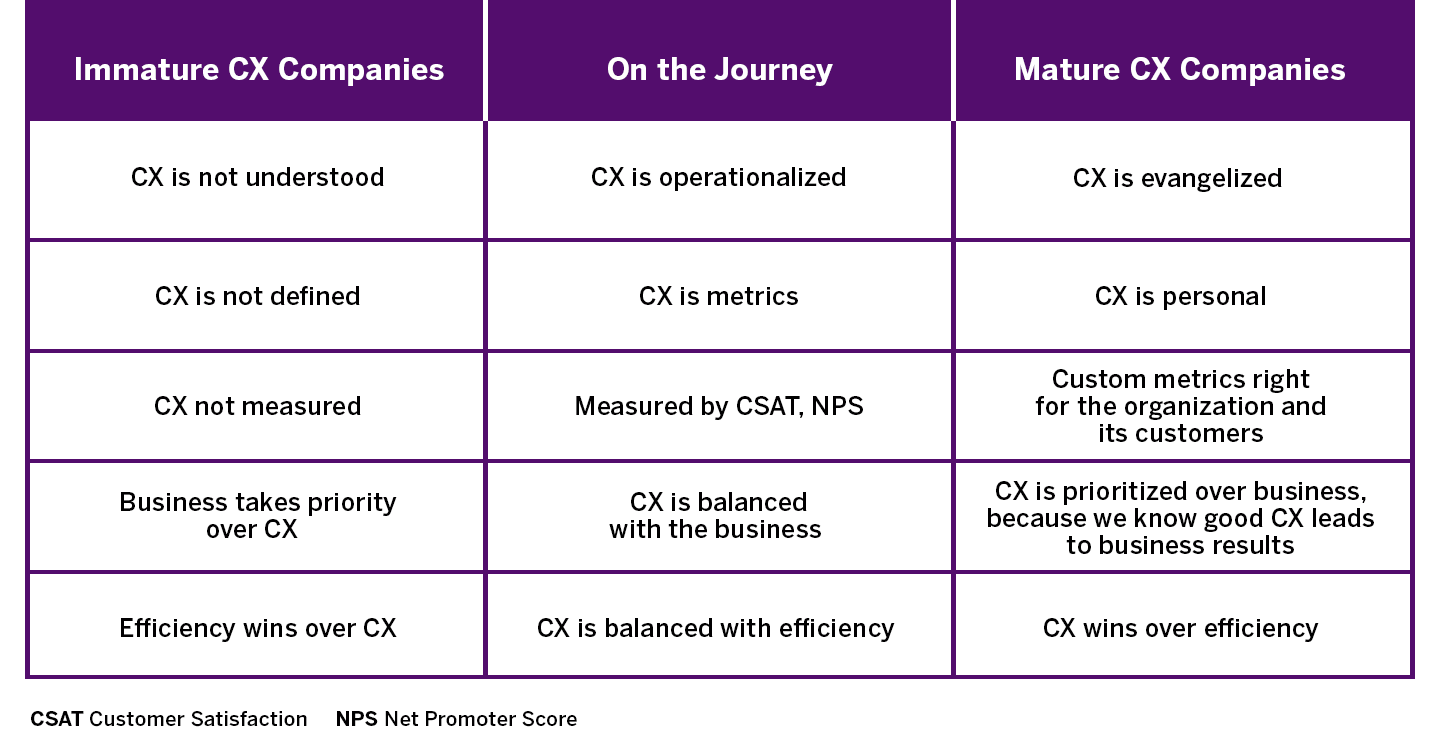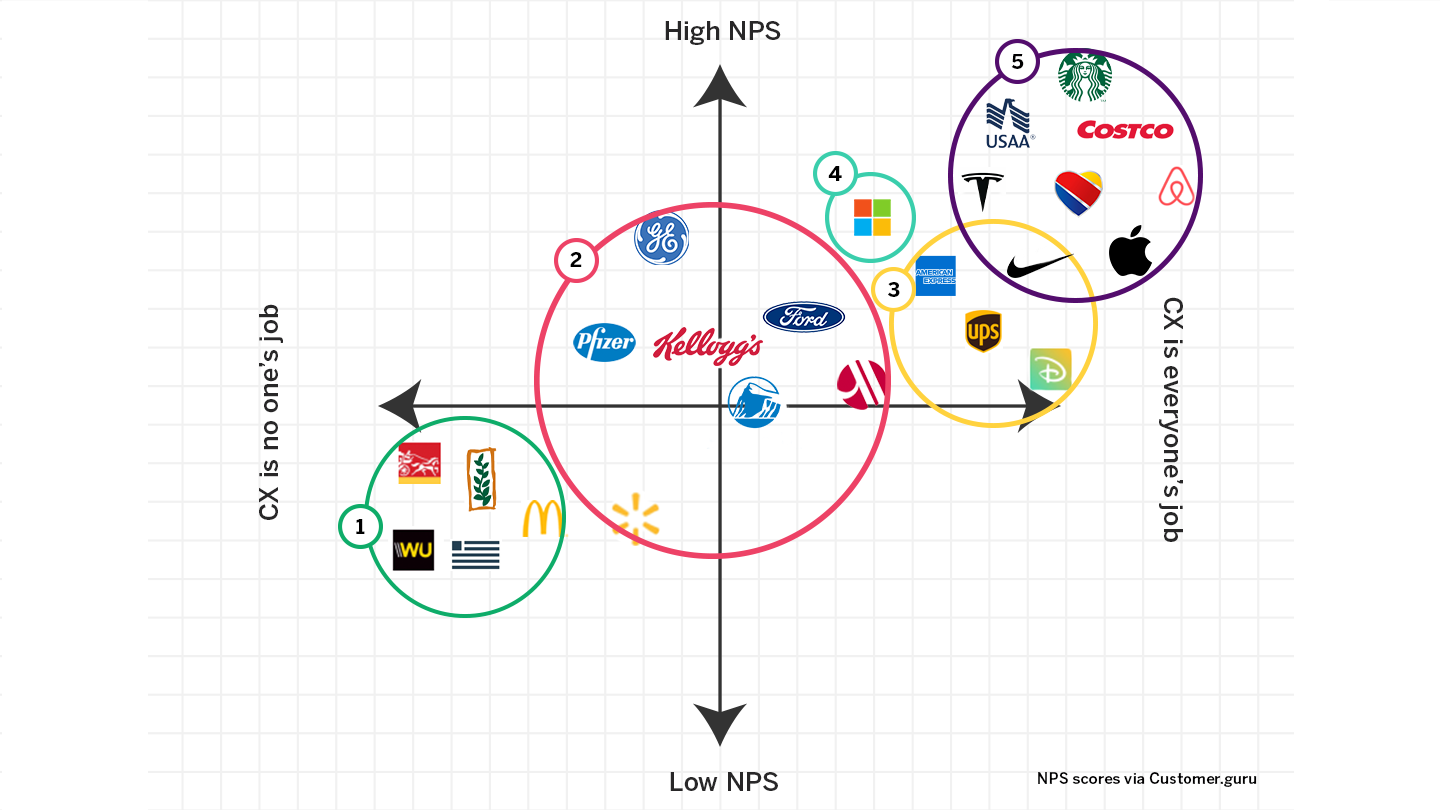
What Leading CX Companies Still Aren't Paying Attention To
Why do some enterprises struggle to create and deliver delightful customer experiences, while others — regardless of their size or maturity — seem to win on their CX? Below, we’ll offer some considerations for those organizations and leaders that find themselves grappling with this dilemma.
Let’s first define customer experience (CX), which is comprised of all interactions and impressions people have with an organization over time. Interactions include all customer touchpoints, from web or mobile interactions to conversations with an employee in-store or over the phone. Impressions can be anecdotes from friends or colleagues about a brand, as well as news or headlines from earned or unearned media, PR and social media channels. Finally, over time denotes that these interactions go beyond the purchase point, beginning with pre-purchase and extending much further into user journeys. All these things together shape peoples’ opinions about a brand, and in turn can have real economic impact on the company.
The larger the organization, the more challenging it can be to impact and measure customer experience. And, like trust, one negative experience can ruin a lifetime of positive experiences. For multi-channel organizations, there is a lot of opportunity for experience gaps in handoffs.
Here’s an example of a customer experience gone wrong :
- I’ve just experienced a product failure in a new digital app.
- I go to the company’s website, but it does not clearly state who to contact for support.
- Eventually I find a chat feature, which is actually a bot that directs me to phone a call center.
- The customer service call starts with a long wait time, and then I am transferred to the wrong department.
- The department that is supposed to handle the call realizes that this problem is too technically complex.
- The call is escalated, but then is dropped in transfer without me receiving the help I need.
- To further exacerbate matters, I am serendipitously served up a social media ad promoting the product’s reliability.
In this unfortunate scenario, which department is accountable for the negative customer experience? Is it the product group, the website design, the unresponsive chat bot, the call center representative, technical support, the brand team who created the ad, the marketing agency who placed the ad or the phone company who dropped my call?
At frog, we are frequently contacted by one of these departments to help improve customer experience. They may ask us to design a new product, a new website or to redesign the entire call center experience. But the reality is that until the entire ecosystem has been designed to prioritize the customer experience over all other metrics (e.g., sales, call wait times, site clicks, case resolutions, clickthroughs), and until customer experience is integrated into all existing touchpoints, the company is not going to see a significant impact.
The Rising Bar
The focus on customer experience by the likes of Airbnb, Apple, Starbucks, Southwest Airlines, Tesla and other CX leaders has had a profound impact on both consumers and businesses across all industries. For example, as a financial services company, you may pride yourself on how well your experience compares to your peers in the space. However, every user of your product, from a student saving money to a high-level asset manager, is consciously or subconsciously comparing your experience to that of Instagram, TikTok and YouTube.
We conducted research to understand what it takes to become a customer-centric enterprise, not just from a strategic perspective but also from an organizational design perspective. Our key take-away? Anyone who tells you they have the secret recipe is lying to you!
There is no one size fits all approach (to CX)
CX Executive Summary
While there are many approaches to transforming into a CX-led company, there are a few consistent considerations.
CX in the DNA
- Culture is the key to growing and internalizing CX from the bottom up.
- The older the company, the more difficult it is to pivot to CX.
- Unless you were “born with” a CX ethos, the idea that “it’s everyone’s job” equates to “it’s no one’s job.”
The Path to CX
- There is no single, correct org design. You must consider and mitigate the risks of each org possible design.
- The path to CX maturity takes an average of five years.
- Although B2B CX leadership is rapidly growing, consumer companies have a slight advantage over B2B companies.
Roles and Ownership
- A Chief Customer Experience Officer (CXO) can be critical to bridge and lead a company’s transformation.
- CX sometimes emerges from marketing or technology, sometimes from design, sometimes from customer success.
- Careful coordination and integration between design, marketing, technology, strategy and insights is the key to accelerating impact of CX initiatives.
The CX COE
A COE (sometimes referred to as Center of Excellence or Center of Expertise) can be extremely helpful when standing up a new function within an organization. Often, functions like HR, finance, legal, design or UX may benefit from operating as a COE. COEs may be small and focused or large and scaled. There are five typical CX COE models. Download the interactive guide to see which one will have the greatest impact in your organization.
The Road to CX Maturity
The journey to a truly delightful customer experience is not for the faint of heart. It’s time to ask yourself: Where is your organization on the road to CX maturity outlined below?

The Bottom Line
In our analysis, we identified a few key take-aways for those starting on this journey. See the chart below for examples of how real brands fit into the CX maturity landscape.

The older the company, the more difficult it can be to achieve a high NPS (Net Promoter Score), since the idea that CX should be everyone’s job can be foreign.
Companies that are trying to break into the top–right quadrant find a Chief Customer/Experience Officer to be critical in helping push the organization into a CX mindset.
Older companies can drive lasting success by maintaining a customer-first mindset. American Express began as a travel services company with an emphasis on customer convenience, and is one of few financial services companies in the top-right quadrant. Disney is also an outlier, due to their inception as a storytelling organization.
Some companies have learned how to sharpen their CX focus. Even though Microsoft began its journey with a very low CX mindset, CEO Satya Nadella realized in 2014 that they “needed to build deeper empathy for our customers and their unarticulated and unmet needs.”
Today’s top CX companies were founded with a CX ethos. They are known for their service orientation and were created with a customer-centric purpose.
Keeping Your Eye on the Prize
How will you know when you have arrived? There are three key indicators that your organization has reached CX maturity:
- Every decision that every employee in the company makes is tested with the question, “How will this help our customer?”
- You do not need to ask or study what other companies are doing to advance customer experience.
- The CXO may no longer be needed.
Start with hard measurements to see the heart measurements.
While there are many ways to get there, we see the role of CXO as critical in moving an organization from the mindset that CX is no one’s job to the mindset that CX is everyone’s job. The executive-level impact, the focus and accountability, as well as the ability to educate the organization on great CX is critical to success.
Your organization may be looking to leading CX companies for insights, but what these CX leaders aren’t doing is studying others — they’re focusing on their customers, not the competition. If you’re ready to take the next step in your journey towards becoming a CX-led organization, find out what organizational design model is right for you with our Choose Your Own Adventure quiz, and start a conversation with a frog Org Activation expert.

Linda provides a broad range of consultative services to build capability and improve organizational performance with clients globally. After more than two decades leading organization transformations from within, Linda brings empathy for leaders driving culture change, innovation and growth in organizations from startups to Fortune 500.

Yukari is an Associate Strategy Director and frog New York Studio Org Design Lead. Trained as an architect, she works with teams and organizations to adopt human-centered design-thinking. Her experience in design encompasses architectural and interior design, organizational design, team effectiveness, and culture change both internally and externally for organizations, from startups to large enterprises. Understanding design’s implications on culture, she engages with organizations throughout their transformation processes.
We respect your privacy
We use Cookies to improve your experience on our website. They help us to improve site performance, present you relevant advertising and enable you to share content in social media. You may accept all Cookies, or choose to manage them individually. You can change your settings at any time by clicking Cookie Settings available in the footer of every page. For more information related to the Cookies, please visit our Cookie Policy.



